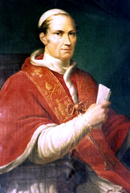1823 papal conclave
This article needs additional citations for verification. (June 2015) |
| Papal conclave September 1823 | |
|---|---|
| Dates and location | |
| 2–28 September 1823 Quirinal Palace, Papal States | |
| Key officials | |
| Dean | Giulio Maria della Somaglia |
| Sub-dean | Bartolomeo Pacca |
| Camerlengo | Bartolomeo Pacca |
| Protopriest | Giuseppe Firrao |
| Protodeacon | Fabrizio Ruffo Dionigi |
| Election | |
| Vetoed | Antonio Gabriele Severoli |
| Elected pope | |
| Annibale della Genga Name taken: Leo XII | |
 | |
Following the death of Pope Pius VII on 20 August 1823, a papal conclave was held to determine his successor. The conclave began on 2 September and ended 26 days later with the election of Cardinal Annibale della Genga who became Pope Leo XII.
Pius VII had reigned as Pope for what was then considered a very long pontificate (he was elected in 1800). During his reign as Pope, the Catholic Church had faced, in the French Revolution and its aftermath, the most severe attack on its power and legitimacy since at least the Reformation – some might say since Theodosius made Christianity the state religion of the Roman Empire.
Description
During Pius VII's papacy, the cardinals had tended to divide into two groups, the zelanti and the politicani. The zelanti were more radically reactionary than the politicani and wanted a highly centralised Church and vehement opposition to the secularising reforms that had resulted in France from the Revolution spreading to the Papal States. The politicani, though anti-liberal, were much more moderate and favoured a conciliatory approach to dealing with the problems new ideologies and the incipient Industrial Revolution were creating. The leader of this faction was Pius VII's Cardinal Secretary of State, Ercole Consalvi, but the zelanti wanted a much less moderate pontiff and they set fervently to this task from the time of Pius VII's death.
The length of Pius VII's papacy had a significant influence because of the forty-nine electors who participated in the conclave, only Giulio Maria della Somaglia and Fabrizio Dionigio Ruffo were already cardinals when Pius VII was elected in 1800. Thus, forty-seven of the forty-nine electors had had no practical experience electing a Pope before this conclave.
A number of cardinals were thought at the beginning of the conclave as possible successors to Pius VII. Antonio Gabriele Severoli was at first seen as the most likely papabile, but the veto of Francis I, Emperor of Austria ruled him out when he looked to have a reasonable chance.
Francesco Saverio Castiglioni then took over as the most likely candidate. The deceased pope Pius VII had in fact seemingly endorsed Castiglioni by having referred to the latter as Pius VIII,[1][2] and indeed the candidate who was eventually elected predicted during the conclave that Castiglioni would someday reign under that name (as he did, succeeding the elected Leo in 1829). Castiglioni lost support in the 1823 conclave when the zelanti Cardinals came to realize that he was quite close to Consalvi.[1][2]
Following the decline of Castigioni's support in this conclave, the experienced Cardinal della Somaglia then had a turn as a possible candidate, but for some the mere fact that he had signed his letters "Citizen Somaglia" during the occupation of the Papal States by Napoleon I of France ruled him out.
It was only then that the eventual winner, Vicar of Rome Annibale della Genga, appeared, proposed by the zelanti. Whilst his tall, ascetic look and reactionary reputation was not an attraction for the politicani, the fact that he was seemingly at death's door seemed an attraction for those cardinals by now desperate for a resolution of the conclave. As a result, Della Genga was elected on 28 September and took the regnal name Leo XII.
Leo XII was crowned as Pope on 5 October 1823.
See also
| Duration | 26 days |
|---|---|
| Electors | 53 |
| Present | 49 |
| Absent | 4 |
| Veto used | by Emperor Francis I of Austria against Antonio Gabriele Severoli |
| DECEASED POPE | PIUS VII (1800–1823) |
| NEW POPE | LEO XII (1823–1829) |
References
- ^ a b Valérie Pirie. "The Triple Crown: An Account of the Papal Conclaves - Leo XII (De la Genga)".
- ^ a b Valérie Pirie. "The Triple Crown: An Account of the Papal Conclaves - Pius VIII (Castiglione)".
